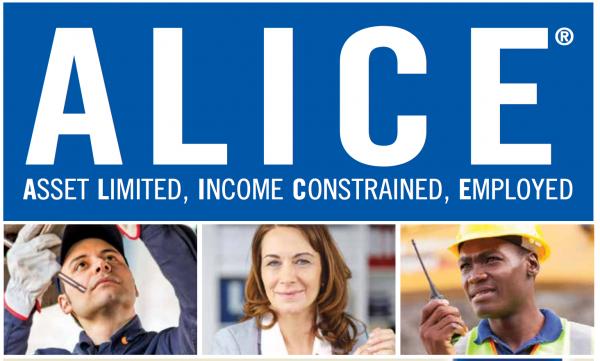
Image from a report on financial insecurity in New York State recently published by the United Way. Click here for the full series of reports.
Even above the poverty line, households across New York State aren't making enough money to get by.
That's the message of a recent report published by the United Way, which takes an in-depth look at household finances across the state and concludes that although just 15 percent of New Yorkers live below the federal poverty line, 44 percent are unable to afford their local cost of living and are facing serious financial insecurity.
The report is part of a nationwide United Way project to study so-called "ALICE" households -- an acronym that stands for "Asset Limited, Income Constrained, Employed." According to the report, ALICE households are those whose income lies between the poverty level and a minimum "survival budget" required to afford the basic necessities of life: housing, childcare, food, healthcare, transportation, taxes and other expenses. The ALICE threshold varies depending on local cost of living, but the statewide average for a family of two adults, one infant and one preschooler is $62,472.
Although the statewide economy improved between 2007 and 2014, the picture for ALICE households hasn't gotten any better. In that time, the percent of households with income at or below the ALICE level went from 41 percent in 2007 to 43 percent in 2010 and 44 percent in 2014, the report said. At the same time, inequality has been on the rise in New York State; the top 20 percent of households now earn 54 percent of statewide income, while the bottom 20 percent takes home just three percent. The difference between the top and the bottom, researchers say, is greater in New York State than anywhere else in the country.
To figure out what life is like in New York State for households below the ALICE threshold, United Way researchers looked at data from a variety of state and federal sources to see how household income varies across the state, and how it relates to things like local cost of living, employment, household family structure and ethnicity. The researchers found a high proportion of households below the ALICE line in many different kinds of communities, ranging from 28 percent in Saratoga County to 71 percent in the Bronx. Both metropolitan New York City and rural upstate New York were found to have high proportions of households living below the ALICE line. The picture is a little brighter in the wealthier, more suburban counties just outside New York City, where both poverty rates and ALICE rates are slightly lower. Here's a quote from the report:
Defying many stereotypes, ALICE households are working households, composed of women and men, young and old, of all races and ethnicities, and they live in every county in New York – urban, suburban, and rural.
When households fall below the ALICE line, researchers write, their financial pain hurts not only them, but the wider community as well:
When ALICE households cannot make ends meet, they are forced to make difficult choices such as forgoing health care, accredited child care, healthy food, or car insurance. These “savings” threaten their health, safety, and future – and they reduce productivity and raise insurance premiums and taxes for everyone. The costs are high for both ALICE families and the wider community.
Locally, the picture for households across the five counties of the Catskills -- Delaware, Greene, Schoharie, Sullivan and Ulster -- is fairly similar to the statewide figures. Here are a few local figures from the report:
Delaware County
- Below poverty line: 14 percent
- Below ALICE line: 44 percent
- Household survival budget for one adult: $19,620
- Household survival budget for a family of four: $56,496
- Median household income: $44,183
Greene County
- Below poverty line: 13 percent
- Below ALICE line: 44 percent
- Household survival budget for one adult: $20,628
- Household survival budget for a family of four: $58,608
- Median household income: $49,864
Schoharie County
- Below poverty line: 13 percent
- Below ALICE line: 40 percent
- Household survival budget for one adult: $22,092
- Household survival budget for a family of four: $61,356
- Median household income: $51,873
Sullivan County
- Below poverty line: 14 percent
- Below ALICE line: 46 percent
- Household survival budget for one adult: $23,280
- Household survival budget for a family of four: $60,948
- Median household income: $53,219
Ulster County
- Below poverty line: 12 percent
- Below ALICE line: 45 percent
- Household survival budget for one adult: $22,032
- Household survival budget for a family of four: $71,592
- Median household income: $58,093
The report breaks down the data to a finer level, with statistics on towns, villages and Census-designated places. Within counties, there is a lot of variation from place to place. One interesting observation: Villages tend to have higher rates of financial insecurity than the larger towns they are located in. Some local figures show a disconnect between rates of poverty and rates of financial insecurity -- like the hamlet of Phoenicia, where poverty is fairly low at 8 percent, but only 31 percent of households are making enough to meet the local survival budget.
Below are some detailed figures from the five-county Catskills region. Note: The Gini coefficient is a measure of income inequality that ranges from 0 (perfect equality) to 1 (perfect inequality, with one person receiving 100 percent of the income). Read more on Wikipedia.










